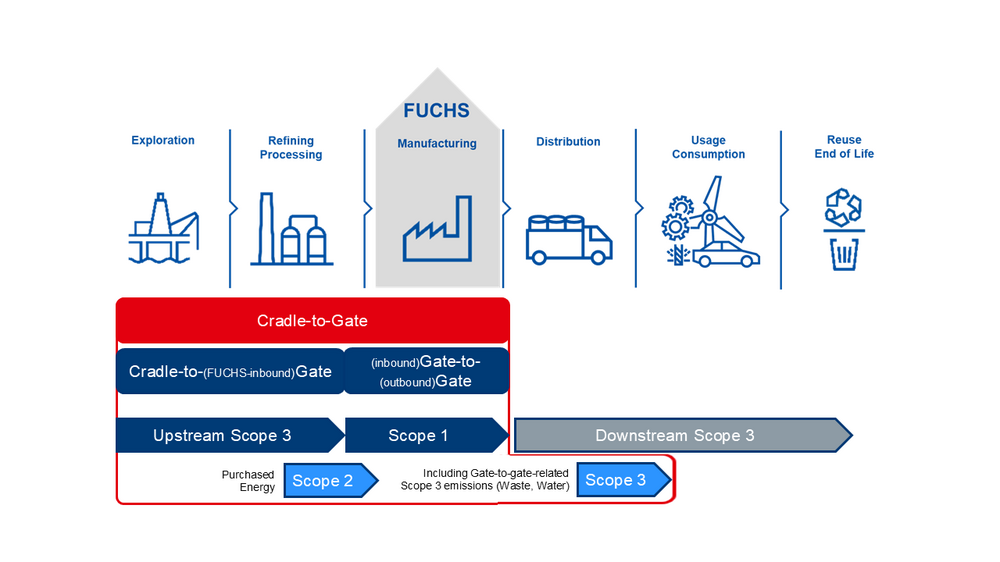Product Carbon Footprint
With the EU climate targets, more and more companies are focusing on their own emissions and a possible climate neutrality of business operations. The calculation of the product carbon footprint (PCF) is a major factor in this context as it summarizes all emissions along the value chain which are related to the product.
What is the PCF?
When calculating the PCF, all CO2-emissions generated by the product along the value chain, from raw materials through packaging all the way to disposal, are recorded. This method of assessing the complete life cycle is also called "cradle-to-grave". Whereas a partial calculation of the PCF, namely "cradle-to-gate", includes all processes from the extraction of resources (cradle) to the product leaving the company gate (gate).
The cradle-to-gate approach (scope) is currently most commonly used for products whose place of use, duration of use, or, for example, end-of-life treatment is not known once the product reaches the outbound gate ready for sale.
To enable a comprehensive and representative result, not only CO2-emissions are recorded, but also CO2-equivalents of other climate-damaging gases such as methane (CH4) and nitrous oxide (N2O) are included in the calculation.
Why calculate the PCF?
Recording the PCF enables a holistic understanding of a product's impact on the environment. This allows for the identification and analysis of which phases of the value chain are particularly impactful and thus determines the next course of action to reduce emissions. Furthermore, it creates transparency for customers who are environmentally conscious in their purchasing decisions.
How does FUCHS calculate the PCF?
As part of the FUCHS2025 strategy, we are continuously working to further reduce our emissions.
The PCF of a FUCHS product contains not only the emissions from our own operations and to produce the product (“Gate-to-Gate”), but also the most relevant Scope 3-emissions from the upstream supply chain, mainly being caused by the raw materials used, their upstream packaging and transportation into FUCHS.
Downstream Scope 3 emissions are outside the system boundaries and therefore not in scope.
Methodology
In order to support this development with data and make it transparent, FUCHS has published its own methodology for partial PCF calculation (cradle-to-gate). The methodology is based on ISO 14067:2018 and the Greenhouse Gas Protocol Product Standard, which are the most common and accepted standards on PCF methodology. In addition, the latest version of the FUCHS methodology also follows the recently published industry standard of UEIL and ATIEL, which has been certified by an independent third party (TÜV Rheinland).
The "cradle-to-gate" scope and thus the resulting PCF include all greenhouse gas emissions from our upstream supply chain (cradle-to-FUCHS-inbound-gate), as well as the emissions at FUCHS (gate-to-gate). The emissions taken into account are defined according to the known Scopes 1-3 of the Greenhouse Gas Protocol (GHG Protocol) (see graphic above). Since FUCHS calculates a partial PCF in the scope cradle-to-gate, any emissions from the downstream supply chain (downstream scope 3) are not included.
The methodology furthermore aims to create transparency for our customers on the one hand by publishing how FUCHS calculates the footprint of its products. On the other hand, it is intended to serve as a technical guide for our suppliers. The resulting standardized calculation allows for the comparability of the data provided and the calculation of a meaningful PCF for FUCHS products. After all, only if the input data for the raw materials used have been uniformly calculated and delimited can they be used to calculate a representative PCF.
Compensation is not included when calculating the FUCHS-PCF.

PCF methodology
Find here the published methodology to calculate the Product Carbon Footprint.
Version 2, December 2024
Certificate
FUCHS appointed TÜV Rheinland to certify our methodology document and our automated calculation method. Find the certificate here.

Why is FUCHS developing its own methodology when there are standards such as ISO 14067 and sector-specific standards?
Recognized standards such as ISO 14067 are generally valid and provide the framework for calculating PCFs. However, these standards have a comprehensive claim to validity, which means that they must be applicable to a wide variety of products from very different and sometimes highly complex value chains. Therefore, these general standards can't provide detailed instructions for example for lubricants. In these cases, it is necessary to specify how the standard is to be applied to lubricants. To this end, the following specifications must be made:
- What is the objective of the calculation?
- What is included in the calculation system, what is not?
- In the case of raw materials, some of which originate from compound processes, how are the resulting emissions allocated to the large number of products that are created in parallel in the process?
In order to uniformly address these complex issues, the standard also provides for so-called "sector-specific" standards. These provide standardized rules on how the general standard is to be applied in a very specific production sector. However, for a long time there was no sector-specific standard for lubricants available. For this reason, FUCHS has actively contributed to a task force of UEIL and ATIEL members to develop a corresponding European sector-specific standard for lubricants, greases and other specialities. This PCF methodology was published in October 2023 and verified by an independent third party (TÜV Rheinland) in October 2024.
However, even an industry standard inevitably leaves open detailed questions that can only be answered by individual companies, such as how data is collected and validated. FUCHS therefore still needs its own PCF methodology, which describes exactly how FUCHS collects and validates data as well as how FUCHS calculates PCF values. FUCHS complies 100% with the requirements of the industry standard, which itself fully complies with the underlying ISO 14067. This has been confirmed by an independent third party (TÜV Rheinland). A common calculation basis and the required transparency of the calculation assumptions are of great importance for the reliability of the PCF data.
Are there already PCFs available for all FUCHS Products?
With the publication of the methodology, FUCHS has taken an important step in defining the procedure and, particularly, in showing our suppliers the format in which we require data from them (so-called primary data). In addition, we have developed an automatic ERP-based PCF calculation tool, which enables an automatic calculation of PCF values at scale applying our methodology. This calculation process has also been reviewed and successfully certified by the independent third party (TÜV Rheinland) and is initially available in the EMEA region. Therefore, FUCHS has set the next milestone and is one of the first lubricant suppliers to have implemented both a methodology and its practical implementation in accordance with the industry standard. Nevertheless, a prerequisite for a reliable PCF calculation of all FUCHS products are reliable PCF data for all our raw materials, which can only be obtained from our suppliers.
Thus, we are working closely with our key suppliers to obtain primary data from them for all raw materials in accordance with our methodology. Only once we have received the relevant data from all suppliers for a product, we can calculate a PCF for the product. Widespread availability of PCF data will therefore still require intensive preparations.
Generally calculated values from third parties, so-called secondary data, which are based on industry average values, are only to be used in exceptional cases when calculating the PCF. For this purpose, FUCHS works with partners who can calculate specific secondary data with the knowledge of the process used, the regional influences and the origin of the raw materials.
FUCHS understands that our customers rely on our PCF data for their sustainability strategies and reporting obligations. We are therefore working on a solution to calculate PCF values for all products on the best available data basis. However, the PCF calculation of the FUCHS portfolio is a continuous process, as both data availability and data quality will increase over time.

